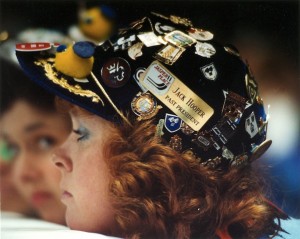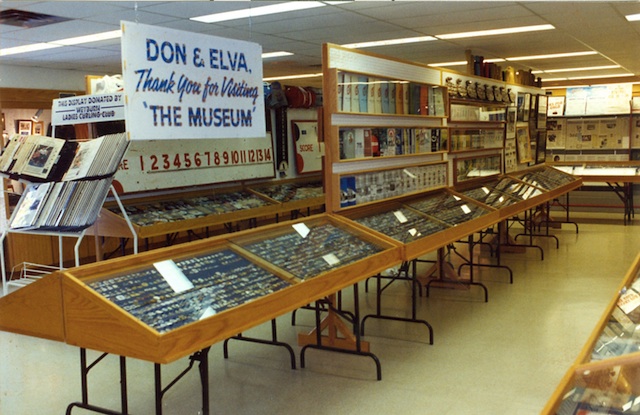For Curling’s “Pinheads”, the Fun is in the Hunt
Bob Barquest doesn’t know exactly how it happened. It just did.
One day he started collecting curling pins, and before he knew it, he had hundreds. Then thousands.
Like a weed that overran the garden, he was soon knee-deep in pins.
“It’s a great hobby, says Barquest, a former president of the Pacific Coast Curling Association, “but it can get out of hand.”
Like most hobbies, pin collecting is enjoyed by many, but is dominated by a small group of hardcore aficionados. Barquest, who lives in White Rock, B.C., is just one of them. Then there’s Larry McGrath in Dodsland, Sask., Winnipeg’s Roger Degagne, Dave Thomas of London, Ont., Calgary’s Curly Waltz, Keith Forbes of Hartney, Man., and Dave Phillips of Red Deer, Alta. It’s believed there are about 25 serious collectors in Canada, and the hobby has become a significant part of their lives.
Together, they have cornered the market on the rarest and most valuable curling pins, and they are still collecting.
Many of them shop and swap their way across the country, following one or more of the Season of Champions or international events, setting up tables in the arena concourse to display their pins. No major curling event would be complete without them.
It’s not a cheap hobby. Travel and accommodation to attend these events can run up into the thousands a year. And then there’s the cost of the pins, which can be quite expensive.
So what obsession drives these “pinheads”, as some people call them, to travel the country and devote a large chunk of their time, and money, to this hobby?
They all agree that, unlike people who collect coins or stamps, their hobby is more about people and the stories behind the pins. It’s a social thing. Pin trading is a chance to meet like-minded collectors to talk curling, their hobby, and to wheel and deal. And if no trade is made, at least it’s a chance to chat.
“It’s a great way to meet and interact with people,” says Forbes, who has been collecting since 1960.
Degagne, a former competitive curler, agrees.
“I just took the social aspect from the ice to the pin collecting,” he says. “I’ve got friends from St. John’s, Newfoundland, to Bob Barquest in B.C.”
Pin trading is an art form. You need to know how to barter and know the worth of individual pins. The trading itself is usually one-for-one, unless somebody thinks they have a pretty special pin and demands an arm and a leg for it.
“We’ve all got traders,” says McGrath. “When we get together, we start dickering. This for that. Actually, I’m not very good at it, but I try.”
Most of the big collectors “fell” into the hobby. Forbes started collecting pins in 1960 when the late Gordon Hudson, a Hall of Fame curler out of Manitoba, presented him with a box of 56 pins at his junior curling windup party.
McGrath, a three-time Canadian Mixed champion who also represented Saskatchewan at the 1974 Brier, had the great fortune to be handed four rare McDonald Brier Heart pins while he was watching the 1962 Kitchener Brier. McGrath figures he has amassed around 4,000 pins today. And while that number is impressive, it pales in comparison to others.
Waltz may have the biggest private collection of curling pins in the world — somewhere around 30,000, and counting. “I still haven’t gone through them all,” he says.
He moved to the head of the pack recently by buying two huge collections that were available in Saskatoon and Regina.
“He (Waltz) has the deepest pockets of all of us,” says Degagne.
Curling pins come in different shapes and colours, but in one general size, about the size of a loonie. There are Season of Champions pins, world pins, sponsors pins, club pins, provincial association pins and volunteer pins.
The old pins used to be fairly simple in design, featuring a club or host city’s name, a date and some sort of logo. But today’s pins are much more elaborate and colourful.
“We call them limited edition, miniature works of art,” says Chris Pasterfield, vice-president of Laurie Artiss Ltd. in Regina, which has a working relationship with the Canadian Curling Association to produce pins for all its major events and internal needs. The company, which has two full-time designers on staff, also produces provincial and club pins, as well as Olympic pins.
The general public will gobble them up, but for the big pin traders, they are on the hunt for something more elusive. Their eyes are forever casting about for the Holy Grail — they crave pins they are missing to enhance their collection.
“We want the pins that are hardest to get,” says Forbes. “For a true collector, the joy is in the hunt.”
The rarest and most valuable pins are the so-called “gold heart” pins from 1927, the first year of the Brier. Only 12 were made. The CCA is in possession of four of them.
“That sucker is hard to come by,” says McGrath, who is missing that pin for his collection.
Degagne, meanwhile, covets the 1940 Winnipeg Brier “door” pin.
The fact is, they all need something.
“You never, ever, it seems, get everything,” Barquest says. “There’s always one, two, three elusive pins. That’s what brings you back.”
These collections can be worth a lot of money. Waltz figures his collection is worth a whopping $100,000. McGrath values his in the $35-40,000 range.
Joe Daley, who owns a collectibles store in Winnipeg that deals in sports memorabilia, has no doubt these collections are worth some big money.
“With any type of collection, it’s all determined on who’s buying and selling and whether you can find similar items,” says Daley, a former goalie with the Winnipeg Jets. “These collectors know they have something rare, and they know other people want them. So that makes them quite valuable.”
But value doesn’t matter much to the big collectors. They’re not in it for the dough.
McGrath, for instance, is going to give his away when the time comes he can no longer travel the country to attend events.
“Someday I’m going to turn them over to a curling hall of fame,” he says. “I’m hoping people will get as much fun looking at them as I have collecting them.”
All the top collectors are senior citizens, in their 70s or 80s. They’ve been collecting for decades. But where’s the next generation of pin collectors?
McGrath doesn’t know if there will be one.
“I really wonder about that,” he says. “It seems like there are no younger people getting involved.”
Forbes agrees:
“Younger people don’t seem to be interested in that stuff,” he says.
Degagne has a different take on it.
“I may give my collection to a local curling club,” he chuckles, “because I don’t want my kids or grandkids getting into this. It’s an insane hobby.”






